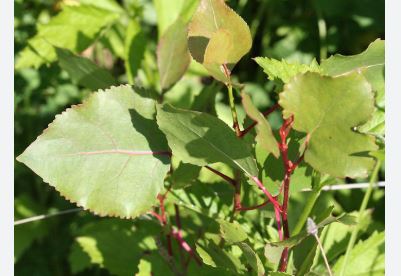
Cottonwood trees fall under the genus Populus in the willow family, Salicaceae. They are specifically within the section *Aigeiros*, commonly known as cottonwoods or poplars. These trees are dioecious, meaning male and female flowers are on separate trees, leading to the production of cotton-like seeds from female trees.
History: Cottonwoods have been significant in North American history, particularly among Indigenous peoples who used them for medicinal purposes, canoe construction, and as a food source. Their fast-growing nature made them key in early colonial times for quick timber. The name “Cottonwood” reflects the fluffy seeds that float through the air, a characteristic noted by early settlers.
Native Area and Characteristics: Cottonwoods are native primarily to North America, with species like Populus deltoides (Eastern Cottonwood) found across the eastern U.S. and Canada, Populus fremontii (Fremont Cottonwood) in the Southwest, and Populus trichocarpa (Black Cottonwood) in the West. They are known for their rapid growth, reaching heights up to 100 feet, with broad, triangular leaves, and a penchant for wet environments like riverbanks. Their bark is typically greenish-gray when young, turning dark and deeply furrowed with age.
USDA Zones: Cottonwood trees have a wide adaptability across USDA Hardiness Zones. Eastern Cottonwoods are generally suited for zones 2-9, while Black Cottonwoods thrive in zones 3-8. Fremont Cottonwoods are more suited to the warmer zones, from 3-9, reflecting their southwestern distribution. This broad range across zones underlines their versatility but also means specific species might not be suitable everywhere due to climate variations.
Cottonwood Trees
Eastern Cottonwood (Populus deltoides)
- Characteristics: It’s one of the largest North American hardwood trees, reaching heights of 70-100 feet. The leaves are triangular with a pointed tip, and the bark turns from smooth and greenish-gray to dark gray and deeply furrowed with age.
- Range: Predominantly found in the eastern United States and parts of Canada, thriving along riverbanks, floodplains, and wet areas.
Plains Cottonwood (Populus deltoides ssp. monilifera)
- Characteristics: Similar to the Eastern Cottonwood but adapted to the drier plains environment. It has a more spreading crown and can grow to similar heights.
- Range: From the Great Plains to the Midwest, often in riparian areas.
Rio Grande Cottonwood (Populus deltoides ssp. wislizeni)
- Characteristics: This variant has a narrower crown and is less tall than its relatives, with leaves that are more oval than triangular.
- Range: Along the Rio Grande in Texas, New Mexico, and parts of Mexico.
Lombardy Poplar (Populus nigra ‘Italica’)
- Characteristics: Known for its columnar shape, this is more of a cultivar than a natural species. It has a fast growth rate but is less long-lived.
- Range: Widely planted for ornamental purposes across temperate regions, not naturally occurring in North America.
Black Cottonwood (Populus trichocarpa)
- Characteristics: The tallest of the cottonwoods, potentially reaching 150 feet. It has broad, shiny leaves with white undersides.
- Range: Western North America, from Alaska to California, mainly along streams and rivers.
Fremont Cottonwood (Populus fremontii)
- Characteristics: Recognized by its deeply furrowed bark and leaves with scalloped edges. It has a broad, open crown.
- Range: Southwestern U.S., with a presence in California, Arizona, Nevada, Utah, and parts of Mexico.
Narrowleaf Cottonwood (Populus angustifolia)
- Characteristics: Features very narrow leaves compared to other cottonwoods, giving it a unique appearance. It’s smaller in size.
- Range: Rocky Mountains and adjacent areas, from Wyoming down to New Mexico.
Swamp Cottonwood (Populus heterophylla)
- Characteristics: This species has variable leaf shapes on the same tree. It’s adapted to wetter environments, often found in swamps.
- Range: Southeastern U.S., particularly in swampy areas from Maryland to Florida.
Necklace Poplar (Populus lasiocarpa)
- Characteristics: Noted for its thick, corky bark and leaves that have a unique texture. It’s less common in cultivation.
- Range: Limited to higher altitudes in western China and parts of Southeast Asia.
White Poplar (Populus alba)
- Characteristics: Known for its white, downy undersides of leaves. It’s a smaller tree with a spreading habit.
- Range: Native to Europe, Asia, and North Africa but widely naturalized in North America due to planting.
Balsam Poplar (Populus balsamifera)
- Characteristics: Has a balsam-like fragrance from its resinous buds. The leaves are ovate with finely toothed margins.
- Range: Northern North America, from Alaska to Newfoundland, often in moist soils.
Carolina Poplar (Populus x canadensis)
- Characteristics: A hybrid of Eastern Cottonwood and Black Italian Poplar, it grows quickly and has a straight trunk.
- Range: Widely planted across temperate zones for timber, not a wild species.
Chinese White Poplar (Populus tomentosa)
- Characteristics: Has leaves with a tomentose (fuzzy) underside, giving it a silver appearance from below.
- Range: Native to China, used for timber and shade in its native range.
Korean Poplar (Populus koreana)
- Characteristics: A species with heart-shaped leaves, it’s smaller and more ornamental than many cottonwoods.
- Range: Endemic to Korea, with some cultivation in similar climate zones.
Sichuan Poplar (Populus szechuanica)
- Characteristics: This species has a more rounded leaf shape and is used for timber in its native areas.
- Range: Central and western China, particularly in Sichuan.